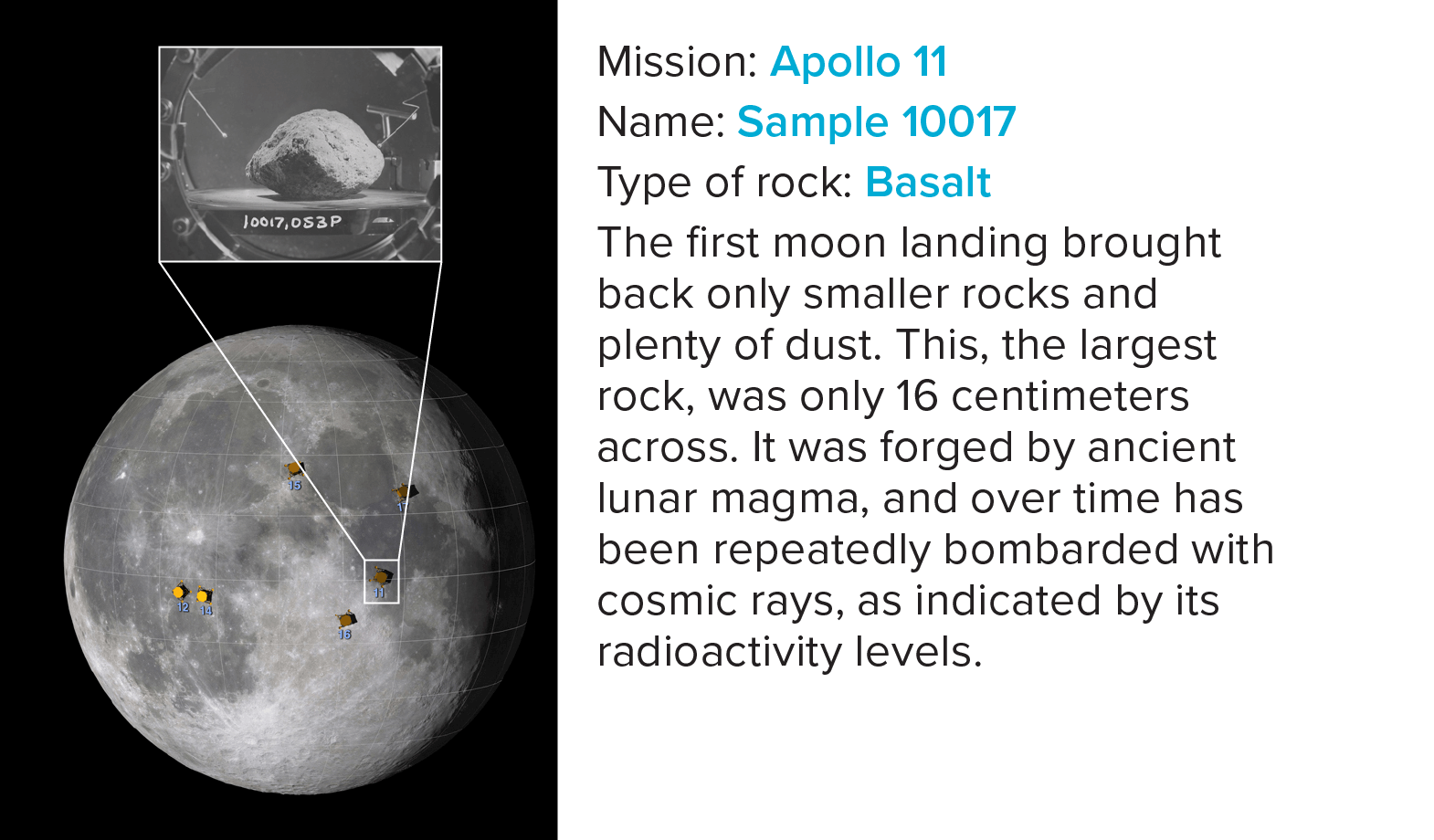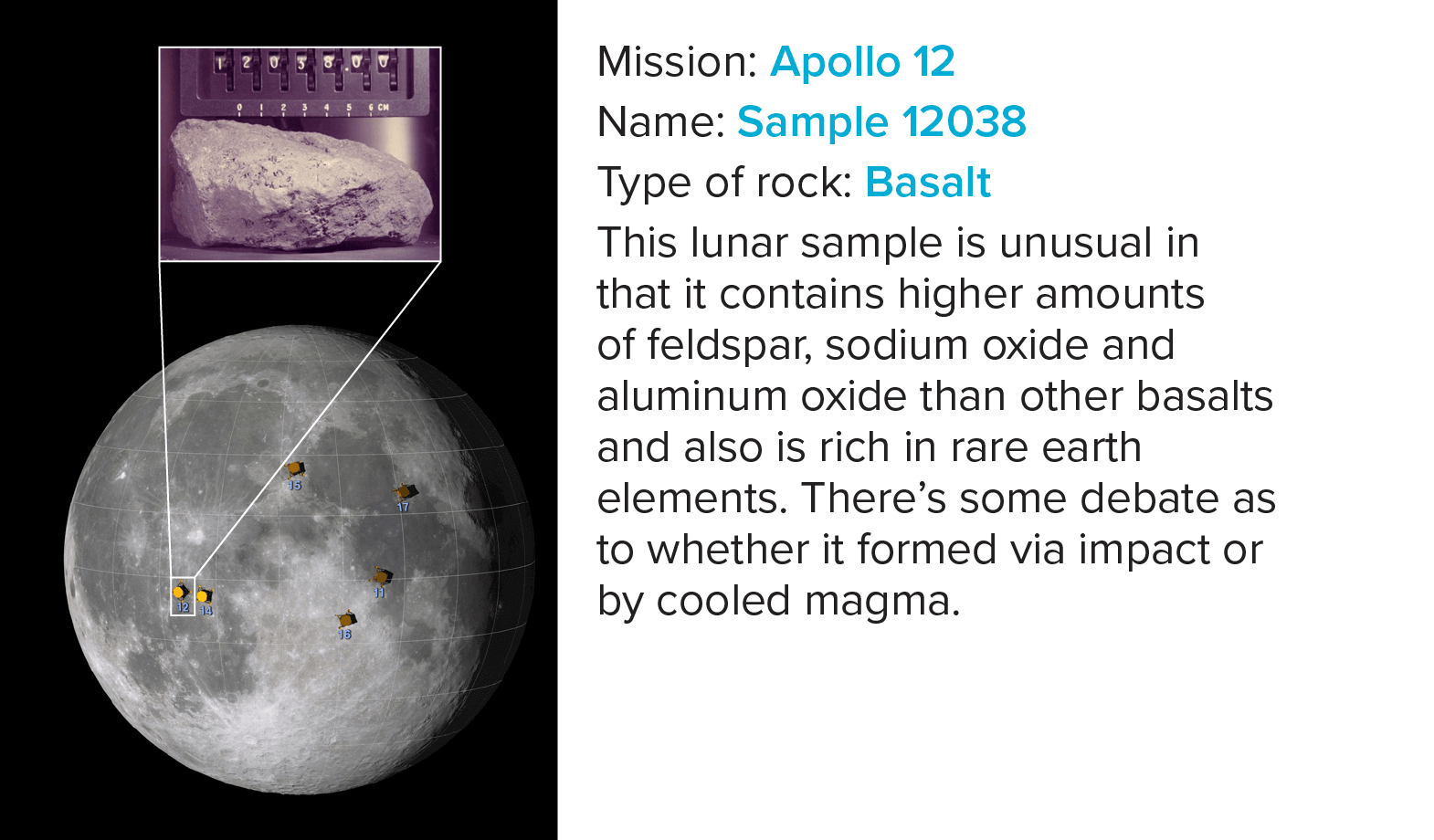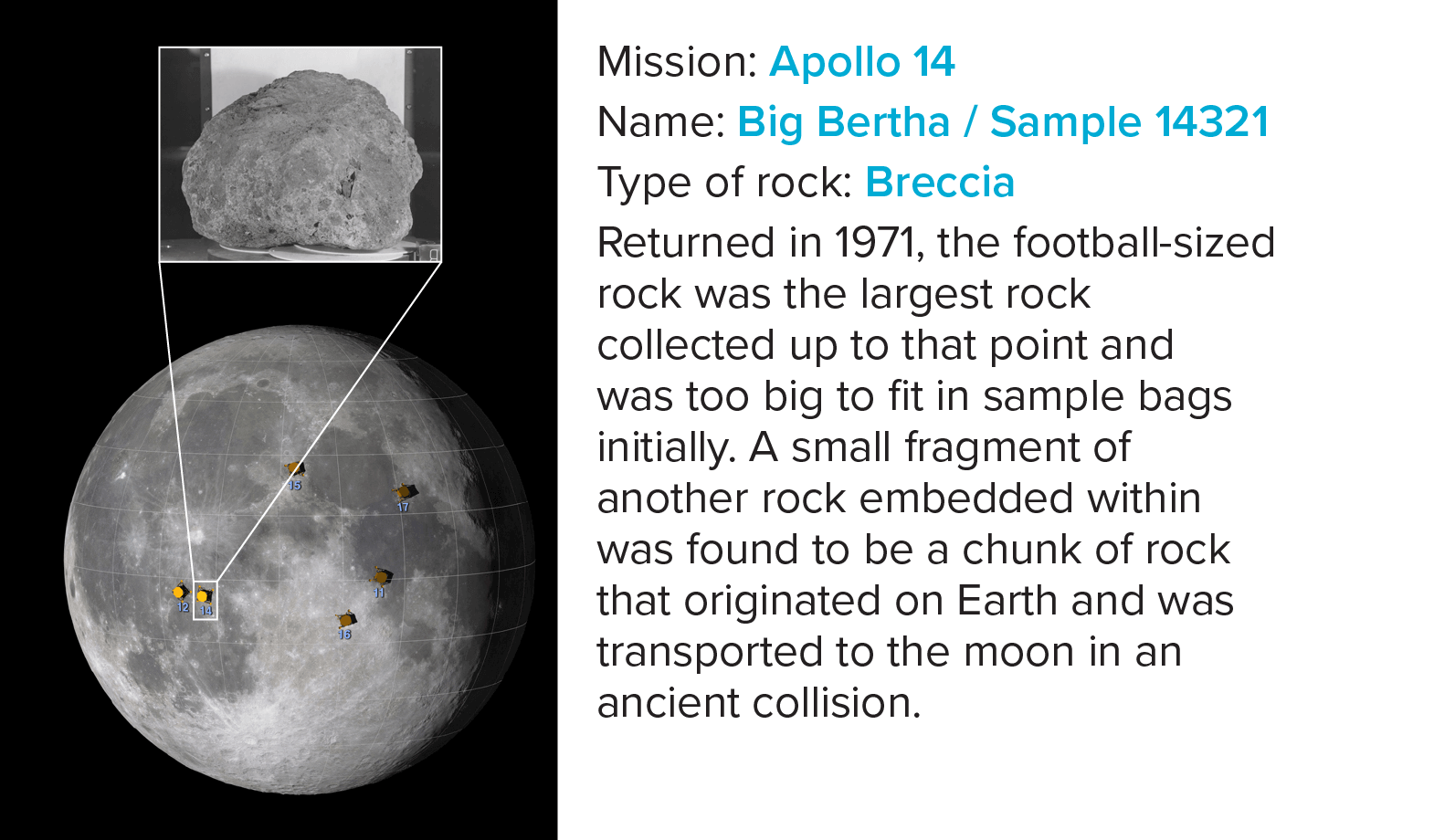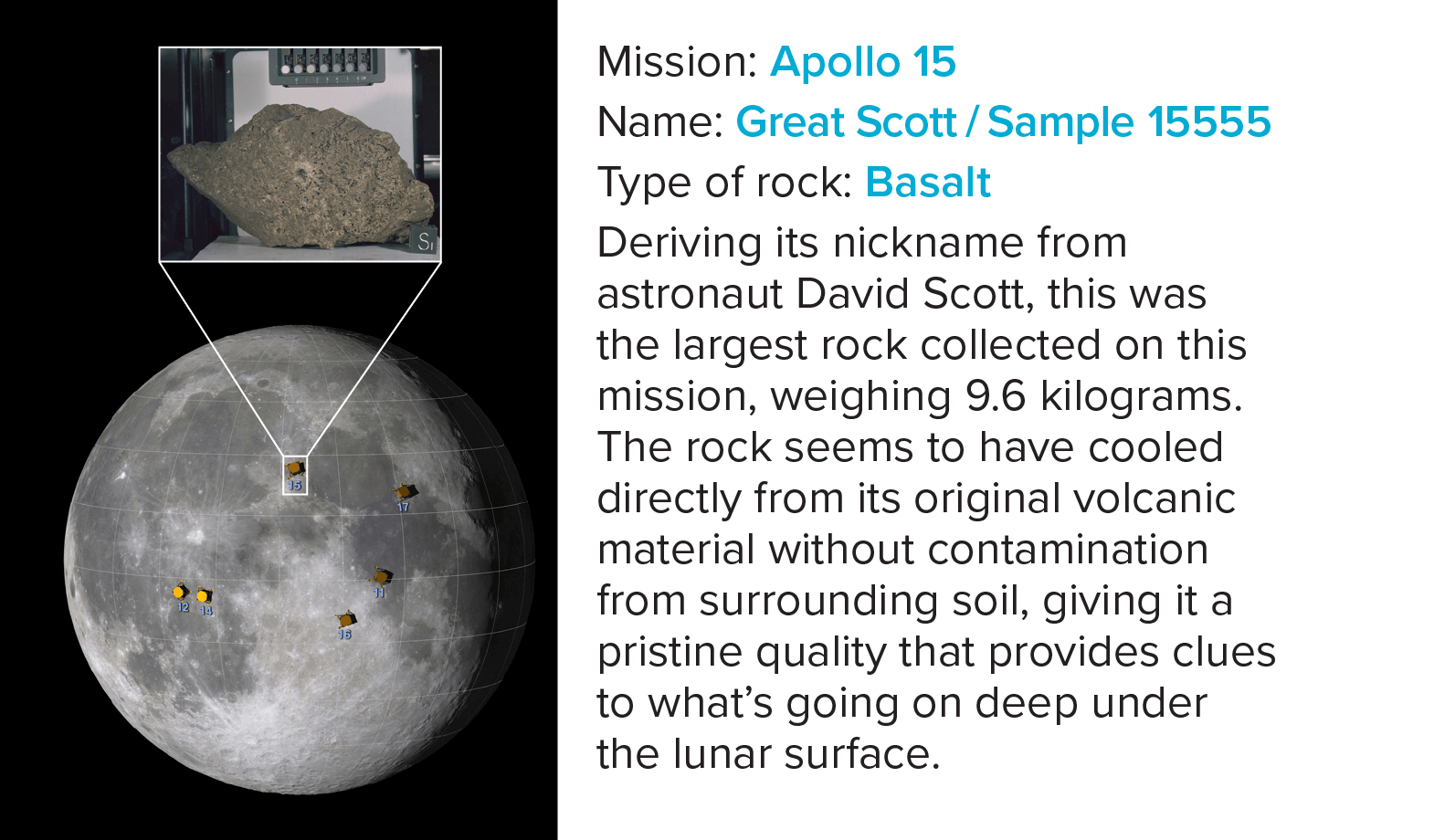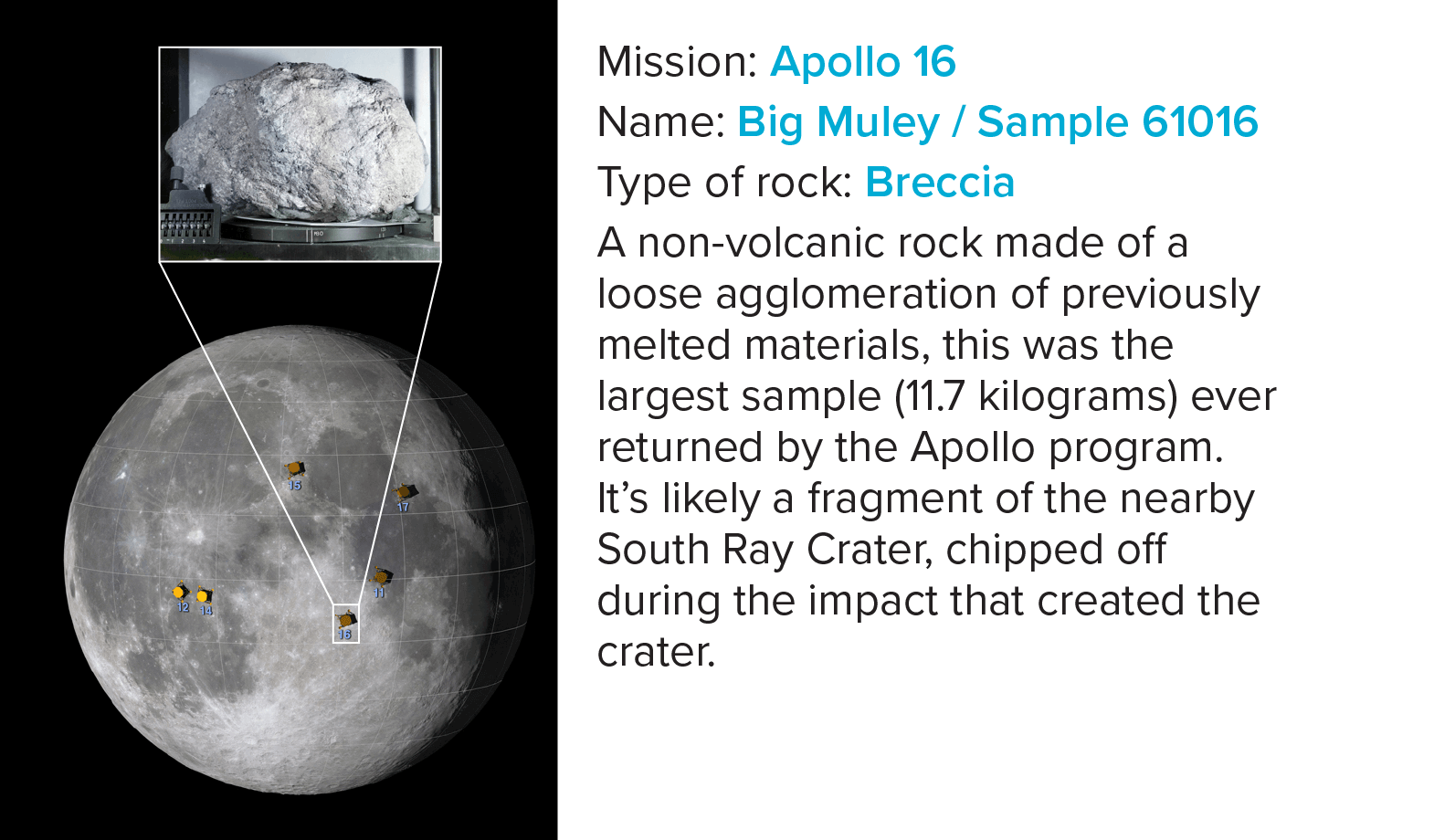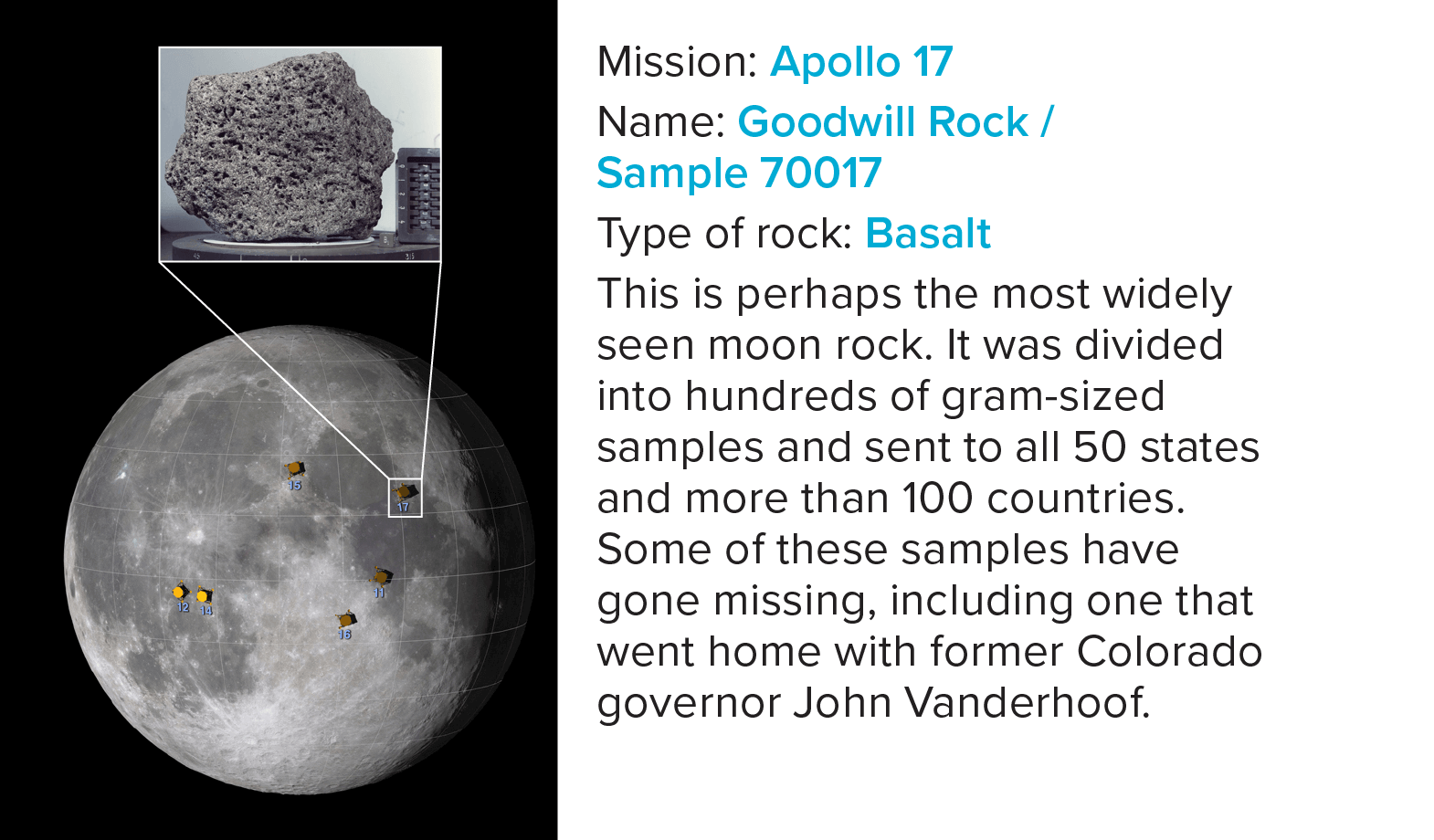When Neil Armstrong took one small step from his spindly spacecraft onto the surface of the moon half a century ago, he began a story that would revise science’s knowledge of our origins.
From 1969 to 1972, six Apollo missions hauled back 382 kilograms of rocks and soil. Those samples revealed much about our cosmic neighbor, including its likely origin as a piece of Earth. But beyond an understanding of the moon itself, the Apollo moon rocks held a history of our planetary neighborhood, encoded in a chemical language.
“The moon is the Rosetta Stone of the solar system,” says Samuel Lawrence, a planetary scientist at NASA’s Johnson Space Center in Houston, where most of the lunar samples live today.
To astronomers, one of the most exciting aspects of the Apollo program was the chance to go prospecting on the moon’s surface. Without a substantial atmosphere to erase dings and scratches, the lunar terrain preserves more than 4 billion years of solar system history. Early peeks into the Apollo samples did not disappoint: They revealed for the first time an apparently raucous era, about 3.9 billion years ago, when the moon and Earth were pummeled by rocks from deep space. The quest to understand what happened during that time — an epoch known as the Late Heavy Bombardment — took scientists from the Earth’s pockmarked satellite to a story about the evolution of all the planets.
“It’s a legacy of the [Apollo] program that we learned not just about the moon, but perhaps one of the most fundamental things about the early solar system,” says Brad Jolliff, a planetary scientist at Washington University in St. Louis.
A lot has changed since Apollo, but our exploration of the moon, and even of the samples collected a half-century ago, continues. Robotic spacecraft have mapped nearly every square inch of the lunar surface, and new tools on Earth have allowed researchers to examine the Apollo samples (many still pristine) with increasing sophistication. All this recent intel has raised new questions about the Late Heavy Bombardment and helped guide the way for future exploration.
As the world marks the 50th anniversary of Apollo 11, much will be written about the mission’s historical, political, cultural and technological legacy. But the Apollo program also had a tremendous scientific impact, helping researchers to better understand the history of the moon, and from it, the solar system in general. Studies of scores of lunar samples have forced scientists to continually review, revise and refine their understanding of our planetary family’s first few hundred million years.
“If we want to understand our origins,” says William Bottke, a planetary scientist at the Southwest Research Institute in Boulder, Colorado, “the moon is a fantastic place to pick up this huge amount of missing history.”
Hints of cataclysm
About 10 minutes after Apollo 11 touched down on July 20, 1969, astronaut Buzz Aldrin described the view out the window to mission control: “It looks like a collection of just about every variety of shape, angularity, granularity — about every variety of rock you could find.”
Samples were a high priority. One of Armstrong’s first tasks was to stuff nearly 500 grams of powdery soil plus a dozen rock fragments into a bag so that if the astronauts had to abort the mission, they would at least bring back some small part of the moon. They ended up bringing back much more. During more than two hours traipsing around Tranquility Base, Armstrong and Aldrin collected 22 kilograms of soil and rocks.
An expanse of relatively flat terrain, the Apollo 11 landing site was chosen with a primary goal of touching down and taking off safely. Later mission sites were chosen for specific science goals and required more daring, with astronauts spending dozens of hours exploring rugged landscapes. One thing was clear from Apollo 11, however: The surface was ancient, covered by rocks billions of years old and untouched by air, water or wind.
By relying on several types of radiometric dating, researchers found a curious pattern in the ages of rocks from later Apollo missions. Several rocks collected by Apollo 14 astronauts were of a type that forms when intense pressure fuses older rocks, and all seemed to be about 3.9 billion years old, much younger than the moon itself. A similar pattern showed up in rocks from Apollo 15, 16, 17 and in soil from Luna 20, a robotic mission sent by the Soviet Union in 1972. At sites spread all over the nearside of the moon, many rocks seemed to have formed in the wake of impacts about 600 million years after the moon formed.
In a 1973 paper, planetary scientist Fouad Tera and colleagues, then at Caltech, termed this bombardment a “lunar cataclysm” and wrote that it must “have been quite a show from the Earth assuming you had a really good bunker to watch from.”
That bunker would have been essential. If the moon was getting pummeled, so was Earth. In fact, all the rocky planets — Mercury, Venus, Earth and Mars — must have been bashed by space rocks around the same time. When probes first flew past Mars in 1965 and Mercury in 1974, researchers noticed cratering patterns comparable to those on the moon.
“We had to get comfortable saying there was something in the solar system that went rogue,” says Barbara Cohen, a planetary scientist at NASA’s Goddard Space Flight Center in Greenbelt, Maryland. In 2000, she and colleagues reported that lunar meteorites — chunks of the moon that fell to Earth — showed signs of impacts spanning more than a billion years, but none older than 3.9 billion years, further supporting the idea of a tremendous bombardment that melted and reset the lunar surface. But it was still unclear what could have triggered such widespread destruction.
A “Nice” story
A possible answer came in 2005, when three papers in Nature offered a new story about how the early solar system might have evolved. The tale, based on extensive computer simulations, came to be known as the “Nice model,” named after the city in France where it originated.
Briefly, the story goes like this: Jupiter, Saturn, Uranus and Neptune formed closer to the sun than they are today. Over time, the orbits of Jupiter and Saturn drifted apart as they felt a constant tug from the surrounding interplanetary debris. Eventually, their orbits synced up, and the combined gravitational prowess of these two giants jolted the entire solar system. A subsequent series of close encounters between Saturn, Uranus and Neptune sent asteroids and comets hurtling everywhere, some raining down on the inner planets and Earth’s moon.
With some tweaking to get the timing right, the researchers found that these simulations could explain the Late Heavy Bombardment, as well as a number of peculiarities about the modern orbits of the giant planets and of objects in the Kuiper belt, the icy debris field beyond Neptune.
But like all good whodunits, this one had more twists to come.
“There’s now considerable worry,” Bottke says, that scientists may have misread the bombardment history of the moon. “And this was a worry that even goes back to the Apollo days.” As he and Marc Norman, of the Australian National University, describe in the 2017 Annual Review of Earth and Planetary Sciences, it’s possible that a large impact basin known as Mare Imbrium has interfered with scientists’ sleuthing.
Basin bias
When you see the “man in the moon,” Mare Imbrium is his right eye. This dark patch, roughly 1,000 kilometers across, is a scar left behind by a powerful impact. If debris from this impact rained down all over the nearside of the moon, the Apollo astronauts might have picked up rocks from Imbrium over and over again.
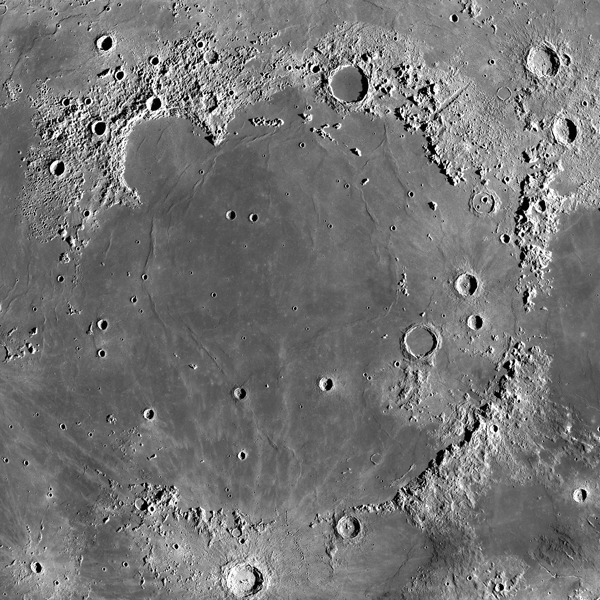
Mare Imbrium, seen in this mosaic from NASA’s Lunar Reconnaissance Orbiter, marks the site of an ancient impact so large it may have hurled debris all over the nearside of the moon. Apollo astronauts might have picked up this debris at far-flung landing sites, making it difficult to piece together the moon’s true history of impacts, with implications for what is known about the early solar system.
CREDIT: NASA
“The folks who did the mission planning back in the ’60s did a phenomenal job,” Lawrence says. “But they didn’t have access to global geochemical data the way we do now.”
Since Apollo, several robotic spacecraft have spied upon the moon in many ways. Over the last 10 years, for example, NASA’s Lunar Reconnaissance Orbiter has mapped more than 98 percent of the lunar surface, including images of the Apollo landing sites so crisp that you can see the foot and rover trails left by the astronauts.
During one of their expeditions, the Apollo 17 astronauts snagged samples from the Sculptured Hills, presumed to be littered with rocks blown out of a nearby basin called Mare Serenitatis (the man in the moon’s other eye). In 2011, Paul Spudis of the Lunar and Planetary Institute in Houston and colleagues analyzed reconnaissance orbiter images of that landing site. The terrain looked a lot more like landscapes near Imbrium, and geologic features extended radially from Imbrium. This means the Sculptured Hills might be littered with rocks from the Imbrium impact and not, as expected, from Serenitatis. Norman and colleagues a year earlier found a similar concern in rocks from Apollo 16, a mission that landed near a large basin named Mare Nectaris. The composition of those samples, too, suggested a strong similarity to Imbrium.
Neither of these (or other) findings proves that the astronauts sampled material only from the Imbrium basin. But it does mean that we can’t say for sure which basins many of the Apollo rocks originally came from. So it’s unclear whether the 3.9-billion-year ages in many lunar samples come from impacts all over the moon or from just one or two sites.
No doubt something significant happened on the moon 3.9 billion years ago. But researchers now debate whether it was a brief flurry of activity or the tail end of a bombardment epoch sustained over hundreds of millions of years. The Apollo record has been invaluable, but large pieces of the moon’s history are still missing. The astronauts explored only a tiny fraction of the moon’s surface. Lawrence says that would be like aliens visiting Earth, landing at the Grand Canyon, and assuming the rest of the planet must be pretty much the same.
That’s why many researchers think it’s time to go back, though not necessarily with astronauts. The last time scientists got samples directly from the moon was 1976, when the Soviet probe Luna 24 returned 170 grams of lunar soil from Mare Crisium. With guidance from the latest orbiter data, a robotic probe could dig up moon dirt from locales far removed from the Apollo landing sites, which could help researchers piece together a clearer timeline of when the moon got pounded and for how long.
Return to the moon
For several years, Jolliff has been pushing NASA to send a robotic mission dubbed MoonRise to the moon’s South Pole–Aitken Basin, far from Apollo’s stomping grounds. At about 2,500 kilometers across, it’s one of the largest craters in the solar system. When this basin formed, it leveled much of the terrain. As presumably one of the oldest impact basins on the moon, it now preserves a record of all the smaller impacts that have hit the area since, including any craters that formed during the alleged Late Heavy Bombardment. A few scoops of soil from this basin may contain a timeline of when all these impacts happened, which could clarify the bombardment history of the moon — and by extension the inner solar system.
But NASA keeps prioritizing other missions over a lunar sample return. MoonRise has lost out to Juno, now in orbit around Jupiter; to Osiris-Rex, currently working to bring back samples from asteroid Bennu; and most recently to Dragonfly, a helicopter-like craft that will fly in the skies of Saturn’s moon Titan. China is aiming to fly a lunar sample return mission, dubbed Chang’e 5, to bring back 2 kilograms of soil from Oceanus Procellarum, a vast plain on the western edge of the moon’s nearside. The Chinese space agency is often quiet about its plans, but news reports indicate that it aims to launch by the end of this year.
The next samples of the moon’s surface may come from Chang’e 5 (illustrated), a Chinese National Space Administration lunar mission designed to land a robotic probe in Oceanus Procellarum later this year and scoop up 2 kilograms of soil for analysis back on Earth.
CREDIT: LOREN ROBERTS / WIKIMEDIA COMMONS
While we wait for someone to bring home more of the moon, the Apollo samples continue to reveal secrets. Recent analyses of the moon rocks using newer methods have shown hints of water on the moon, long thought to be bone-dry. Later this year, nine research teams will start to take a fresh peek at samples from Apollo 15, 16 and 17, including some that have never been opened on Earth.
Apollo marked a turning point in human history. After millions of years of gazing at the universe from the relative safety of Earth, people finally stepped off our home planet and onto the surface of another world. Before Apollo, researchers assumed the solar system had always been neat and orderly. Whatever the truth may be about the Late Heavy Bombardment, the moon rocks point to a much more chaotic and dynamic place than once imagined.
We aimed for the moon and stumbled onto a new story about the entire solar system — a story that scientists are still figuring out 50 years later, one small step at a time.






